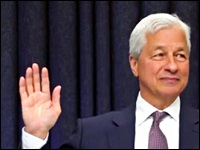By Pam Martens and Russ Martens: April 10, 2023
Jamie Dimon, the Chairman and CEO of JPMorgan Chase, has cranked up his public relations machine since March 16 to promote the narrative that he came to the “rescue” of the plunging regional lender, First Republic Bank. The so-called “rescue” consisted of 11 banks, including JPMorgan Chase, dumping a total of $30 billion in “uninsured” deposits into First Republic.
But one of the bank’s key problems was that it already had too many uninsured deposits. (This was like seeing a house on fire and throwing 11 expensive martinis at it.)
According to First Republic’s regulatory filings, as of December 31, 2022, it had total deposits of $176.25 billion, of which $119.47 billion (or 68 percent) were uninsured. The Federal Deposit Insurance Corporation (FDIC) caps federal deposit insurance at $250,000 per depositor, per bank. But banks such as First Republic, that cater to the very wealthy, have a significant number of customer accounts that dramatically exceed the $250,000 cap. In the digital age, those deposits can rapidly move elsewhere when a bank panic sets in.
The stock market was unpersuaded that this Dimon rescue plan was anything more than a hastily thrown together p.r. stunt. First Republic Bank’s stock closed on March 16 – after the news about the $30 billion hit the wires – at $34.27. It has continued to move lower, hitting $14.03 by the closing bell on Friday. That’s a year-to-date decline of 90 percent – not exactly anyone’s idea of a “rescue.”
S&P Global also wasn’t buying the idea of the “rescue” either. Three days after the p.r. news of the 11 banks tossing $30 billion of uninsured deposits at First Republic, it downgraded the bank’s credit rating by three notches, putting it deeper into junk territory.
Wall Street mega banks have a long history of talking a good game while surreptitiously doing deceitful things behind a dark curtain. Let’s not forget that some of the biggest names on Wall Street, in the leadup to the financial crisis of 2008, were driving the U.S. housing market deeper into despair by shorting (making bets against) the residential mortgage bonds they had sold to their own customers as solid investments.
Our suspicions about the “rescue” of First Republic Bank were aroused further last week when multiple news reports indicated that Morgan Stanley, one of the 11 Wall Street banks that chipped in for the $30 billion “rescue” of First Republic Bank, was now hiring some of its largest advisor teams and providing a home to the billions in assets managed by those teams. (See here and here.)
We decided to take a look behind one of the darkest curtains on Wall Street – the trading that occurs in the Dark Pools owned by these wily mega banks on Wall Street. (See Related Articles below.) Dark Pools are effectively unregulated stock exchanges operating inside the largest trading houses on Wall Street.
Wall Street’s self-regulator, FINRA, after public uproar, began releasing weekly aggregated totals for trading in Dark Pools in 2014. But the data is far from transparent. For example, a number of the Wall Street banks own more than one Dark Pool. There is no way to tell if a two-sided market is occurring between Dark Pools owned by the same parent. There is no hour-by-hour or day-by-day breakdown of trading, just data lumped together for each Dark Pool for an entire week. There is also a multiple-week delay in reporting the data. For example, the most recent data for Dark Pool trading in the shares of First Republic is for the week of March 20.
Despite the Dark Pools continued ability to operate in the shadows, what we could discern from the FINRA Dark Pool data was that there was an absolute explosion in the quantity of shares of First Republic Bank traded by its “rescuers” in their Dark Pools as the bank was plunging in value in mid-March.
The volume of shares traded by Dark Pools went from 2.8 million shares in a little more than 32,000 trades for the week of February 27, 2023; to 13 million shares in more than 123,000 trades for the week of March 6; to an explosion of 70.8 million shares traded in Dark Pools for the week of March 13 in a stunning 653,922 separate trades.
Dark Pools owned by the “rescuers” of First Republic – including JPMorgan Chase, Goldman Sachs, Morgan Stanley, and Bank of America’s Merrill Lynch – were among the largest Dark Pool share traders of First Republic for the weeks of February 27 through March 13.
And this is by no means the full story. As we previously reported, Goldman Sachs Is Quietly Trading Stocks In Its Own Dark Pools on 4 Continents.
Related Articles:
The SEC Is Allowing 5-Count Felon JPMorgan Chase to Trade Its Own Bank Stock in its Own Dark Pools
Dark Pools Traded 791% More Boeing Stock During Week of 737 Max Crash
Another Wall Street Inside Job?: Stock Buybacks Carried Out in Dark Pools


